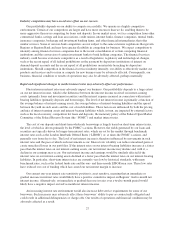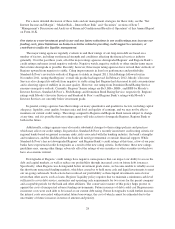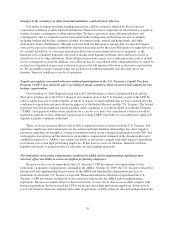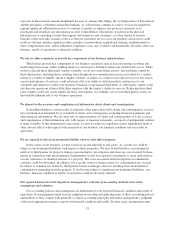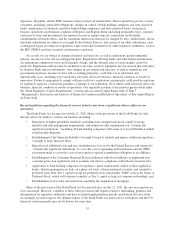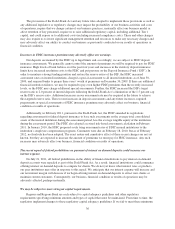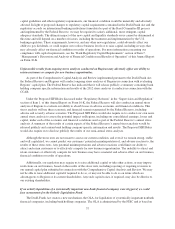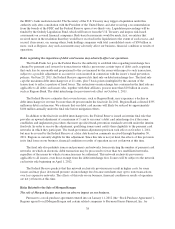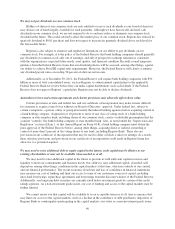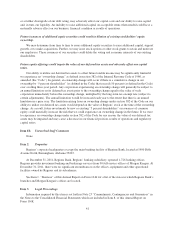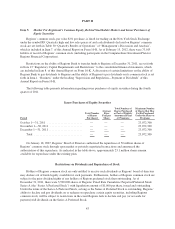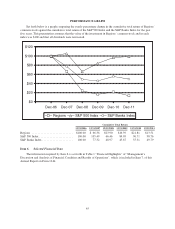Regions Bank 2011 Annual Report Download - page 61
Download and view the complete annual report
Please find page 61 of the 2011 Regions Bank annual report below. You can navigate through the pages in the report by either clicking on the pages listed below, or by using the keyword search tool below to find specific information within the annual report.capital guidelines and other regulatory requirements, our financial condition would be materially and adversely
affected. In light of proposed changes to regulatory capital requirements contained in the Dodd-Frank Act and the
regulatory accords on international banking institutions formulated as part of the Basel Committee III process
and implemented by the Federal Reserve, we may be required to satisfy additional, more stringent, capital
adequacy standards. The ultimate impact of the new capital and liquidity standards on us cannot be determined at
this time and will depend on a number of factors, including the treatment and implementation by the U.S.
banking regulators. These requirements, however, and any other new regulations, could adversely affect our
ability to pay dividends, or could require us to reduce business levels or to raise capital, including in ways that
may adversely affect our financial condition or results of operations. For more information concerning our
compliance with capital requirements, see the “Bank Regulatory Capital Requirements” section of Item 7.
“Management’s Discussion and Analysis of Financial Condition and Results of Operation” of this Annual Report
on Form 10-K.
Unfavorable results from ongoing stress analyses conducted on Regions may adversely affect our ability to
retain customers or compete for new business opportunities.
As part of the Comprehensive Capital Analysis and Review implemented pursuant to the Dodd-Frank Act,
the Federal Reserve and Regions will conduct ongoing stress analyses of Regions in connection with evaluating
Regions’ capital plan. The Federal Reserve has indicated that it will release publicly a summary containing bank
holding company specific information and results of the 2012 stress analyses it conducts in connection with the
CCAR.
Under the Proposed SIFI Rules discussed under “Regulatory Reforms” in the “Supervision and Regulation”
section of Item 1. of this Annual Report on Form 10-K, the Federal Reserve will also conduct an annual stress
analysis of Regions to evaluate our ability to absorb losses in adverse economic and financial conditions. This
stress analysis will use three economic and financial scenarios generated by the Federal Reserve, including
adverse and severely adverse scenarios. The Proposed SIFI Rules would also require us to conduct our own semi-
annual stress analysis to assess the potential impact on Regions, including our consolidated earnings, losses and
capital, under each of the economic and financial conditions used as part of the Federal Reserve’s annual stress
analysis. A summary of the results of certain aspects of the Federal Reserve’s annual stress analysis would be
released publicly and contain bank holding company specific information and results. The Proposed SIFI Rules
would also require us to disclose publicly the results of our semi-annual stress analyses.
Although the stress tests are not meant to assess our current condition, and even if we remain strong, stable
and well capitalized, we cannot predict our customers’ potential misinterpretation of, and adverse reaction to, the
results of these stress tests. Any potential misinterpretations and adverse reactions could limit our ability to
attract and retain customers or to effectively compete for new business opportunities. The inability to attract and
retain customers or effectively compete for new business may have a material and adverse effect on our business,
financial condition or results of operations.
Additionally, our regulators may require us to raise additional capital or take other actions, or may impose
restrictions on our business, based on the results of the stress tests, including rejecting or requiring revisions to
our annual capital plan submitted in connection with the Comprehensive Capital Analysis and Review. We may
not be able to raise additional capital if required to do so, or may not be able to do so on terms which are
advantageous to Regions or its current shareholders. Any such capital raises, if required, may also be dilutive to
our existing shareholders.
If an orderly liquidation of a systemically important non-bank financial company were triggered, we could
face assessments for the Orderly Liquidation Fund.
The Dodd-Frank Act creates a new mechanism, the OLA, for liquidation of systemically important nonbank
financial companies, including bank holding companies. The OLA is administered by the FDIC and is based on
37


